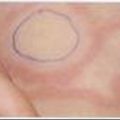8.2 Raised intracranial pressure
Introduction
Normal physiology
Normal intracranial pressure (ICP) is 6–18 cmH2O. It is the product of the intracranial contents mainly blood, brain and cerebrospinal fluid (CSF) and the resistance of the cranial vault. Normal ICP has a diurnal cycle that is higher in the early hours of the morning when one is normally supine during sleep. Therefore the symptoms of raised ICP, such as headache and vomiting, are usually worse in the morning. Intracranial pressure may be raised by anything that can cause an increase in the volume of its contents or a decrease in the size of the cranial cavity (Table 8.2.1). This section will not cover the diagnosis and management of raised intracranial pressure associated with trauma. Those issues are covered in Chapter 3.2.
Clinical features of raised intracranial pressure
Investigations
An MRI scan is more likely to require anaesthesia in younger children, as they usually take longer and patient access is more difficult. Finally, when obtaining CT scans, one must consider the risks of radiation causing cancer, which in a CT scan of the head in a child is estimated to be 1:1000–1:10 000 over the lifetime of the child.1 Head ultrasound is an option for initial imaging in infants. This is good at imaging the lateral ventricles and surrounding structures but dependent on operator experience. However, ultrasound is less able to image the subdural space around the vertex and the posterior fossa region which may need to be considered in the adequacy of the clinical scenario.
Management of raised ICP
In this situation efforts should be directed towards maintaining cerebral oxygenation and perfusion by supporting the child’s ventilation and circulation, if necessary using rapid sequence intubation (RSI) and mechanical ventilation. Some drugs used in RSI and the manipulation of the airway itself may cause a further transient rise in intracranial pressure. Several strategies have been used to avoid this transient rise including administering an IV dose of lignocaine just prior to RSI and giving a ‘defasciculating’ dose of a non depolarising neuromuscular blocking agent just before the Succinylcholine. There are no studies looking at what effect the use of these strategies has on patient outcome. This author?s opinion is that it is more important to avoid hypotension and hypoxia during RSI because there is strong evidence that these are harmful. Therefore this author does not use these strategies because it is a change in the usual practice of the department which more likely to lead to errors and delays in the RSI process. (See the end of the chapter for further reading on this issue). Intracranial pressure can be reduced by giving intravenous mannitol 1 g kg–1 and nursing the patient in a 30° head up position. Mannitol should not be given if the patient has circulatory failure (i.e. hypotension or hypoperfusion) as the osmotic diuresis that it causes could exacerbate the hypoperfusion. Just as in trauma so in medical illnesses C (circulation) comes before D (disability) meaning that a perfusing blood pressure must be maintained if there is to be any cerebral perfusion pressure. There is strong evidence against prolonged hyperventilation because vasoconstriction impairs cerebral perfusion despite the reduction in intracranial pressure. pCO2 should be kept between 35 and 40 mmHg unless the above measures have been unsuccessful or herniation is progressing, in which case the pCO2 can be taken down to 25 mmHg for a brief period while further measures are commenced. Whilst these measures are taking effect consideration and management of the underlying cause should be undertaken. This will be aided by a concise history and some rapid bedside testing such as blood gas, which may reveal conditions such as hyponatraemia or any infusions containing free water. If an infant in this situation does not respond to these measures, a neurosurgeon should be urgently consulted regarding a ventricular or subdural tap via the open fontanelle. In older children who do not respond adequately, the options depend on the clinical situation and the underlying cause. Therapeutic options include: consulting neurosurgeons and getting an urgent CT scan; palliating or treating an underlying cause urgently (e.g. high-dose dexamethasone for vasogenic oedema or hypertonic saline for hyponatraemia); or maintaining cerebral perfusion pressure by maintaining mean arterial blood pressure at above normal levels with fluids and inotropes and reducing cerebral metabolic demand with drugs such as thiopentone. Other neurosurgical interventions include: craniotomy; insertion of external ventricular drain; and insertion of a CSF reservoir or a complete CSF shunt. Where a shunt is already present this may be tapped (see Chapter 8.1 on shunt complications). Consideration should also be given to prophylactic anticonvulsants because seizure will cause a further acute rise in ICP. Once initial stabilisation is underway and neurosurgeons are involved referral to a paediatric ICU is mandatory.
Some particular causes of raised ICP
Pseudotumour cerebri (PTC or benign intracranial pressure)
This condition is characterised by sustained raised ICP causing symptoms similar to a cerebral tumour but with no anatomical abnormality on neuroimaging. It is usually due to decreased CSF re-absorption. PTC has many causes (Table 8.2.2). It is more prone to occur in overweight pubescent girls, in whom no cause is found. The presentation is usually with headaches and vomiting, which are worse in the morning. Some patients may complain of transient visual obscuration with blurring or darkening of vision that lasts less than 30 seconds. Later there may be unilateral or bilateral 6th nerve palsies causing diplopia on lateral gaze. Papilloedema is often the only positive physical finding. The most significant complication of PTC is loss of vision. This begins with an enlargement of the blindspot associated with papilloedema, and later progresses with erosion of the peripheral visual fields. Left untreated the patient with persistent PTC will eventually develop optic atrophy and blindness.
Behrman R.E., Kliegman R., Jenson H.B., editors. Nelson Textbook of Pediatrics, 16th ed., Philadelphia: WB Saunders, 2000.
Salhi Bisan, et al. In defense of the use of lidocaine in rapid sequence intubation. Annals Emerg Med. 2007;49(1):85-86.
Clancy M., Halford S., Walls R., Murphy M. In patients with head injuries who undergo rapid sequence intubation using succinylcholine, does pretreatment with a competitive neuromuscular blocking agent improve outcome?. A literature review Emerg Med J. 2001;18:373-375.
Roberts JR. Clinical Procedures in Emergency Medicine. 3rd ed. Philadelphia: WB Saunders
Robinson N., Clancy M. In patients with head injury undergoing rapid sequence intubation, does pretreatment with intravenous lignocaine/lidocaine lead to an improved neurological outcome? A review of the literature. Emerg Med J. 2001;18:453-457.
Christian Vaillancourt, et al. Opposition to the use of lidocaine in rapid sequence intubation. Annals Emerg Med. 2007;49(1):86-87.




